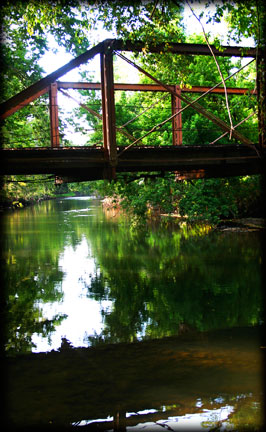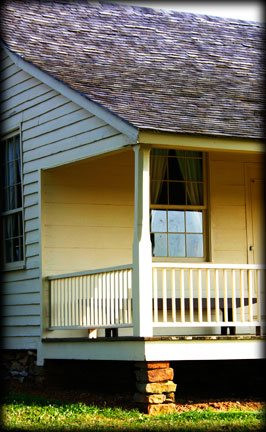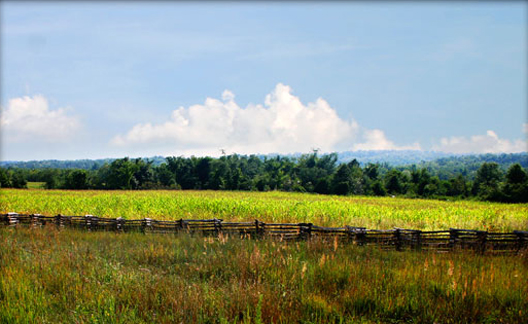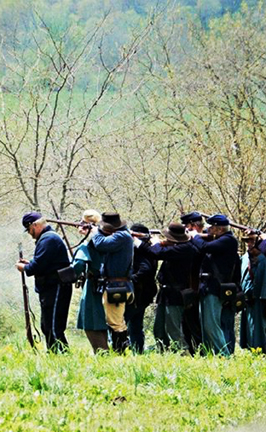Civil War in the Ozarks
It’s easy to forget the war even occurred west of the Mississippi. Not enough has been written about this “Western front,” though a few books do exist. State of the Ozarks is dedicated to publishing as much regional Civil War history as possible. It is our history and heritage. It should not be forgotten.
The Battle of Oak Hills (Wilson’s Creek)
by Joshua Heston
The day of August 10, 1861, dawned clear and warm. Nicholas Bartlett Pearce, 33-year-old Kentucky native and brigadier general in the Confederate States Army, remembered his troops “cheerlessly waiting, many of the troops remaining in position, in line of march, on the road, and others returning, to camp to prepare the morning meal.”
It had been a long night.
The warm air. Fog drifting in the valley. The sounds of men, stirring. Almost light, and in the distance, a hoot owl calling, the old Elizabethan omen of death.
Along and near the banks of Wilson’s Creek, 10 miles southwest of Springfield, Missouri, the Battle of Oak Hills was about to commence.
Pearce’s men, a part of the Confederate States Army and pro-secessionist Missouri State Guard force numbering 13,000, had prepared to march against Federal troops occupying Springfield the night before. A light but steady rain had stopped them.
Rain does terrible things to gunpowder.
As that rain had pattered down the night before, a force of 1,500 Federal troops moved quietly off the old Forsyth Road, stealing through the dense forest east of the creek. The morning sky brightened and those Federal troops — under the command of German-born schoolteacher, now brigadier general, Franz Sigel — were positioned to rain artillery fire down on the Confederate cavalry stirring below in farmer Joseph Sharp’s cornfields.
Rifle fire was heard to the north.
Tempestuous General Nathaniel Lyon — Connecticut-native, radical abolitionist, grasping political appointee — had closed the gap, leading his force of 4,300 Federal troops over the rough hills south of Springfield, west of Wilson’s Creek.
Lyon was, in some ways, a desperate man.
His troops had hounded the pro-secessionist Missouri State Guard, (led by Sterling Price, 51-year-old Virginia native and former Missouri governor) across Missouri.
The pro-secessionist force, composed of 8,000 Missourians loyal to their state, not the Union, was poorly outfitted.
But Lyon, pressed by his superiors, needed a victory. A big victory that would swing Missouri over into the Union, permanently.
Commander of the Western Department, John Fremont, appointed by Lincoln himself, charged with keeping Missouri from the Confederacy, was bogged down in scandal and inexperience.
Lyon’s Union army needed supplies to continue the fight.
Those supplies were not coming.
In desperation, Lyon pushed toward Wilson’s Creek. His forward forces reached a small group of Missouri State Guard cavalrymen and opened fire, forcing the Confederate horsemen to retreat down the oak hills to the creek.
It was the signal for which Franz Sigel was waiting. “I therefore ordered the four pieces [of artillery] to open fire against the camp, which had a ‘stirring’ effect on the enemy, who were preparing breakfast,” wrote Sigel afterwards.
The Confederates in the valley scattered beneath a hail of shells but not before riders were dispatched to other elements of the Missouri State Guard and the Confederate States Army, under command of Kentuckian Pierce, Virginian-turned-Missourian Price, and the tough, leathery Brigadier General Benjamin McCulloch.
Born in Tennessee in 1811, McCulloch was a former Texas Ranger and U.S. marshall. Around Wilson’s Creek, McCulloch held command of 5,000 troops, many from Texas, Arkansas and Louisiana.
Under fire, the Confederate forces regrouped, even as Lyon’s First Kansan and First Missourian regiments reached a scrub-oak covered ridge overlooking the wide valley of Wilson’s Creek. A small contingent of Missouri State Guard was routed from the ridge.
Across the valley, the mid-summer cornfield of farmer John Ray rustled in the morning breeze. Under orders from Lyon, Captain Joseph Plummer led a battalion of US regulars into the valley, across Wilson’s Creek near Gibson’s Mill, and into that corn. His job? To secure the Federal troops’ eastern flank.
South of the Ray House, Confederate artillery — the Pulaski Arkansas Battery — began lobbing shells westward across the valley toward the Kansan and Missourian troops.
Federal artillery, commanded by James Totten, returned fire from Oak Hill, a ridge rapidly earning the new name Bloody Hill. Covered by the Arkansas Battery’s onslaught, General Price led the Missouri State Guard up Bloody Hill. Although driven back by Lyon’s troops, the initiative had been seized by Confederate forces. Across the creek, Captain Plummer attempted to attack the Pulaski Arkansas Battery that was causing so much trouble. As the Federal troops were moving through the Ray Cornfield, they were routed by Confederate riflemen dispatched by McCulloch.
During this time, Franz Sigel made his way northward, directing cannon fire into Confederate cavalry as he went. “We were on the principal line of retreat of the [Confederate] enemy,” he wrote, “and had arrived there in perfect order and discipline.”
Situated on the Sharp Farm and blocking the Wire Road to the south, Sigel was in perfect position to push in behind Confederate forces as they attempted to rush up Bloody Hill.
A lull fell over the battlefields.
“The cessation of the firing on Lyon’s front, the appearance of the enemy’s [Confederate] deserters, and the movement... of the cavalry toward the south — led us into the belief that the enemy’s forces were retreating,” noted Sigel.
Troops were seen coming up the road, looking for all the world like Lyon’s First Iowa Infantry, dressed in militia gray.
A certain Corporal Tod (of the Union’s Third Missouri) was sent forward to challenge them. As he did so, a shot rang out, felling the corporal. Sigel’s men stood, stunned as the “First Iowa” opened fire at point blank range. They were Louisiana troops dressed in Confederate grays.
The 1,500 men under Sigel’s command were driven away in panic. Sigel himself was chased southward all the way to the James Fork ford of the White River, at one point hiding out in a cornfield, pretending to be a Texas Ranger to avoid capture. Franz Sigel arrived back in Springfield late that afternoon to the charges of having forsaken his troops — and of having allowed the plunder of the Sharp Farm.
Likely, it was then he learned of General Nathaniel Lyon’s death.
Shortly after 9:00 o’clock that morning, just as Sigel’s men were fleeing to the south, Sterling Price’s Missouri State Guard attacked in force. The Federal line was nearly broken by the ferocity of the Guard.
In the midst of the firefight, General Nathaniel Lyon — staunch abolitionist, fiery commander — fell, a rebel bullet through his chest. He would die a short time later. He would be the first of many generals, both Federal and Confederate, to die on this war’s battlefields.
Major Samuel Sturgis took command of the Federal forces atop Oak Hill or Bloody Hill.
Shortly thereafter, Colonel Elkanah Greer’s Texas Calvalry led a daring, high-speed charge through the western flank of Union men atop Bloody Hill, causing panic. Confederate troops attacked the Federal lines once again between 10 and 11 o’clock that morning, causing severe losses throughout the ranks.
Although the Federal lines were not broken, troops of both sides were exhausted and running low on ammunition.
Sterling brought his men away from Bloody Hill to re-group. Samuel Sturgis — his Union men demoralized — ordered a retreat back to Springfield. Before long, the Union Army would retire all the way to Rolla. The Battle of Oak Hill (or Battle of Wilson’s Creek as the history books would remember it) was over before noon.
As Federal troops drifted away to the north, they left a battlefield strewn with over 500 dead, and a Missouri forever changed.
By August 30, John C. Fremont — the panicked and inept Commander of the Western Department — declared martial law in Missouri, wresting control away from the state government and all-but declaring war on any Missouri citizen believed to harbor pro-secessionist tendencies.
Missouri would become a land of blood and fire.
Neighbor would turn against neighbor. Farm and town alike would be plundered and burnt. Some soldiers, fueled by greed or hatred, would become “bushwhackers,” guerilla fighters little more than bandits.
It was a time of revenge and lawlessness.
It was a time and place which brought forth outlaws like Belle Star, the Dalton Gang, the Baldknobbers, and Jesse James. It had been the Battle of Oak Hills, just 10 miles south of Springfield, Missouri, that hot summer morning of 1861.
August 27, 2010
plate 1. Ray’s Cornfield, Wilson’s Creek Battlefield. August 28, 2008.

plate 2. Edward Cabin (Sterling Price Headquarters).

plate 3. Chinkapin Oak.

plate 4. Chimney detail.

plate 5. Cabin Curtains.

plate 6. Flower detail.

plate 7. Chinapin Oak 2.

plate 8. Wilson’s Creek Bridge.

plate 9. Flower detail.

plate 10. Ray House.

plate 11. Ray House window detail.

plate 12. Old bridge planking.
Photos taken on August 28, 2008 and May 1, 2010.
REFERENCES:
McPherson, James M., Battle Cry of Freedom: The Civil War, Oxford University Press, New York, 1988
Wilson, Charles Morrow, The Bodacious Ozarks, Pelican Publishing Company, Gretna, Louisiana, 1959
National Park Service (U.S. Department of the Interior), Wilson’s Creek





